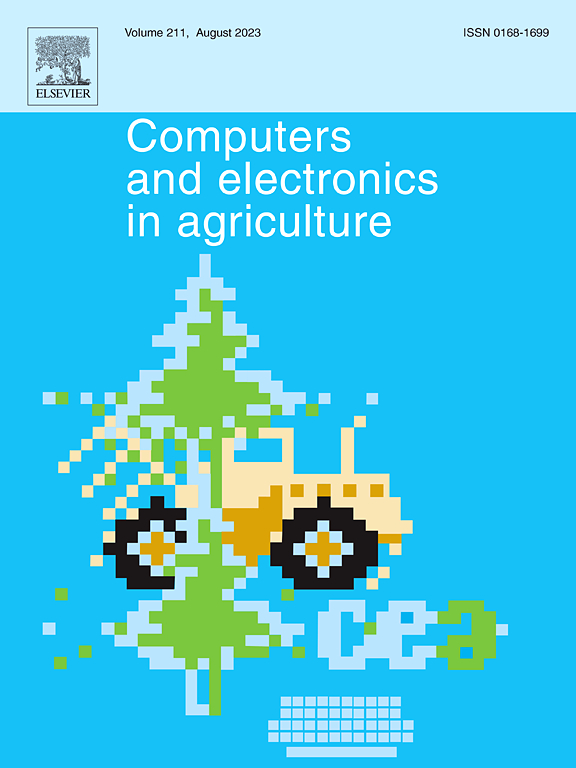优化马铃薯产量制图与预测:结合卫星遥感与机器学习实现可持续农业
IF 8.9
1区 农林科学
Q1 AGRICULTURE, MULTIDISCIPLINARY
引用次数: 0
摘要
精准农业和可持续农业需要作物产量预测和绘图。PEI是加拿大主要的马铃薯生产商。然而,PEI马铃薯产量预测研究有限。这突出了一个文献缺口和需要改进数据驱动的精准农业在PEI。高分辨率卫星图像和机器学习(ML)使农田规模的作物产量制图成为可能。本研究探讨了高分辨率多光谱图像和机器学习在马铃薯产量预测中的潜力。该研究重点研究了2021年和2022年生长季节PEI的四个地块。利用联合收割机和人工挖掘收集的马铃薯作物产量数据进行分析,利用Sentinel-2A和PlanetScope图像建立产量模型。对于这两个传感器,检索植被指数(NDVI、GNDVI、SAVI和EVI)和选择用于作物生长监测的光谱波段,并将其纳入ML模型。利用云计算平台谷歌Earth Engine (GEE)对随机森林回归(RFR)、分类与回归树(CART)和梯度树增强(GTB)三种机器学习算法的性能进行了评价和比较。总的来说,这三种模型在两种传感器的产率预测中都是令人满意的。而基于Sentinel-2A和harvester数据的GTB估算精度略高,R2值为0.71 ~ 0.78,RMSE值为2.82 ~ 5.96 t/ha, MAE值为2.33 ~ 4.2 t/ha。因此,本研究中使用的方法提供了田间规模的实时季节性产量预测图,这将帮助农民确定可变费率应用的目标区域,从而提高资源效率和可持续性。本文章由计算机程序翻译,如有差异,请以英文原文为准。
Optimizing potato yield mapping and prediction: Integrating satellite-based remote sensing and machine learning for sustainable agriculture
Precision agriculture and sustainable farming require crop yield prediction and mapping. PEI is a major Canadian potato producer. However, PEI potato yield prediction research is limited. This highlights a literature gap and the need for improved data-driven precision agriculture in PEI. High-resolution satellite imagery and machine learning (ML) enable field-scale crop yield mapping. This study investigated the potential of high-resolution multispectral imagery and ML for potato yield prediction. The study focused on four plots in PEI during the 2021 and 2022 growing seasons. Potato crop yield data collected using a combined harvester and manual digging were analyzed to model yield using Sentinel-2A and PlanetScope imagery. For both sensors, vegetation indices (NDVI, GNDVI, SAVI, and EVI) and spectral bands chosen for their application in crop growth monitoring were retrieved and incorporated into ML models. The cloud computing platform, Google Earth Engine (GEE), was used to evaluate and compare the performance of three ML algorithms, which are random forest regression (RFR), classification and regression trees (CART) and gradient tree boosting (GTB). Overall, the performance of all three models was satisfactory in yield prediction with both sensors. However, GTB with Sentinel-2A and harvester data gave slightly higher estimation accuracy with R2 values of 0.71–0.78, RMSE values of 2.82–5.96 t/ha, and MAE values of 2.33–4.2 t/ha. Hence, the approach used in this study provides real-time seasonal yield prediction maps on a field scale, which will help the farmers identify the targeted areas for variable rate application, leading to resource efficiency and sustainability.
求助全文
通过发布文献求助,成功后即可免费获取论文全文。
去求助
来源期刊

Computers and Electronics in Agriculture
工程技术-计算机:跨学科应用
CiteScore
15.30
自引率
14.50%
发文量
800
审稿时长
62 days
期刊介绍:
Computers and Electronics in Agriculture provides international coverage of advancements in computer hardware, software, electronic instrumentation, and control systems applied to agricultural challenges. Encompassing agronomy, horticulture, forestry, aquaculture, and animal farming, the journal publishes original papers, reviews, and applications notes. It explores the use of computers and electronics in plant or animal agricultural production, covering topics like agricultural soils, water, pests, controlled environments, and waste. The scope extends to on-farm post-harvest operations and relevant technologies, including artificial intelligence, sensors, machine vision, robotics, networking, and simulation modeling. Its companion journal, Smart Agricultural Technology, continues the focus on smart applications in production agriculture.
 求助内容:
求助内容: 应助结果提醒方式:
应助结果提醒方式:


